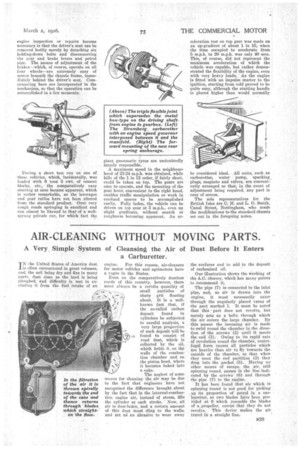AIR-CLEANING WITHOUT MOVING PARTS.
Page 13

If you've noticed an error in this article please click here to report it so we can fix it.
A Very Simple System of Cleansing the Air of Dust a Carburetter. Before It Enters
IN the United States of America dust is often encountered in great volumes, and, the soil being dry and fine in many parts, dust rises as the land, is being ploughed, and difficulty is met in excluding it from the fuel intake of an
engine. For this reason, air-cleaners for motor vehicles and agrimotors have a vogue in the States.
Even on the comparatively dustless roads of this country, however, there must always be a certain quantity of small particles of sharp grit floating about. It is a wellknown fact that, if the so-called carbon deposit found in cylinders be subjected to careful analysis, a very large proportion of such deposit will be found to consist of road dust, which is collected by the oil, which holds it_on the walls of the combustion chamber and on the piston head, where it beconies baked into a cake.
The neglect of some means for cleaning the air may be due to the fact that engineers have not recognised the difference brought about by the fact that in the internal-combustion engine air, instead of steam, fills the cylinder at each stroke. Now, all air is dust-laden, and a certain amount of this dust must clink to the walls, and act a6 an abrasive to wear away the surfaces and to add to the deposit of carbonised oil.
Our illustration shows the Working of the A.C. cleaner, which has many points to recommend it.
The pipe (7) is connected to the inlet pipe, and, as air is drawn into the • engine, it must necessarily enter through the angularly placed vanes of the part marked 1. It must be noted that this part does not revolve, but merely acts as a helix through which the air enters the large chamber. By this means the incoming air is made to swirl round the chamber in the direction of the arrows (2) until it meets the end (3). Owing to its rapid rate of revolution round the chamber, centrifugal force causes all particles which are heavier than air to fly towards the outside of the chamber, so that when they meet the end partition (3) they drop into the pocket (5). Having no other means of escape, the air, still spinning round, passes in the line indicated by the arrows (6) and through the pipe (7) to the engine.
It has been found that sir which is spinning round is not good for picking up its proportion of petrol in a carburetter, so two blades have been provided at 6 which resemble the blades of a, propeller,.except that they do not revolve. This device makes the air travel in a straight line.




























